The theory of demand and supply includes the law of demand and the law of supply. These laws explain the behaviour of demand and supply in response to changing prices. Moreover, there are several other factors that can shift demand and supply. We will discuss these determinants of demand and supply, their laws and exceptions to these laws.
Econometrics Tutorials with Certificates
Demand and its determinants
Price (P)
Generally, the price and demand of a commodity have a negative relationship. That is, a rise in price leads to a fall in quantity demanded and vice versa. Such commodities are also referred to as normal goods. In certain exceptional cases, this relationship is reversed. A fall in the price of commodity results in a fall in quantity demanded as well. These rare goods are called Giffen goods.
Income (Y)
Income and demand tend to have a strong positive relationship in the case of normal goods. A rise in real income or purchasing power leads to an increase in the demand for a commodity. A higher income enables consumers to buy more of that commodity. This is referred to as the income effect, which is positive in the case of normal goods. However, in the case of inferior goods, a rise in real income leads to a fall in the quantity demanded of that commodity. Hence, inferior goods have a negative income effect. This happens in some cases when consumers begin to prefer other goods as their status of living improves with high income.
Tastes and preferences (T)
All consumers have their own habits, subjective tastes and preferences with respect to goods. This inclination towards certain goods or aversion to other goods has a huge impact on demand. This can also affect the elasticity of demand for those goods. For instance, a person who likes coffee will keep consuming it even if its price rises to a certain extent.
Prices of related goods (Pr)
The price of a good as compared to other related commodities is one of the most important determinants of demand. Changes in quantity demanded of a commodity due to changes in relative prices of other related goods is also known as the substitution effect. If a commodity becomes relatively cheaper as compared to its substitutes, the quantity demanded of that commodity will increase.
Expectations (E)
Future expectations can play a huge role in consumer behaviour and their demand for commodities. Suppose, consumers expect a rise in the price of a commodity in future. Then, they will buy more of that commodity at present even at high prices.
Government policy (G)
Government intervention and policy measures can impact the quantity demanded as well. As an example, an increase in taxation levied on a particular commodity will lead to an increase in its price. Therefore, the quantity demanded of that good will fall.
Law of Demand
Other things remaining constant (ceteris paribus), the demand for a commodity increases with a fall in its price and decreases with a rise in its price. Hence, there is a negative relationship between price and quantity demanded.
D = f(P, Y, T, Pr, E, G……)
where Income (Y), Tastes and Preference (T), Price of related goods (Pr), Expectations (E) and Government Policy (G) remain constant.
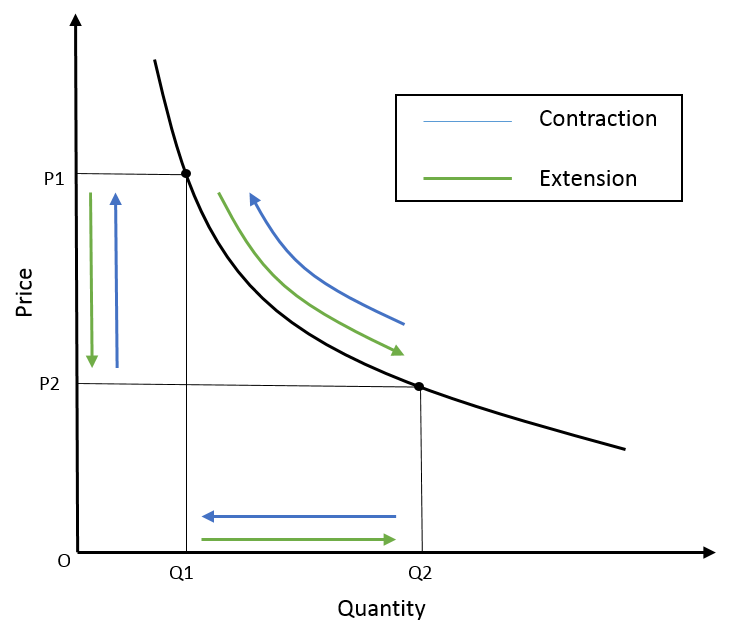
The figure illustrates the Law of Demand, where the demand for a commodity changes in response to its price.
The Extension of demand occurs when the price falls from P1 to P2. This causes the demand to rise from Q1 to Q2. As the price falls, the demand rises.
On the other hand, if the price increases from P2 to P1, the demand for the commodity will fall from Q2 to Q1. This is referred to as the contraction of demand.
Assumptions
The Law of demand aims to understand the effect of changes in price on demand. Hence, it assumes other factors to be constant in order to isolate the effects of price.
- The income of the consumer remains constant
- No change in tastes and preferences of the consumer
- No change in the price of related commodities (substitutes and complementary goods)
- There is no change in the expectations of the consumer
- No change in government policy
Relaxing the assumptions of the law
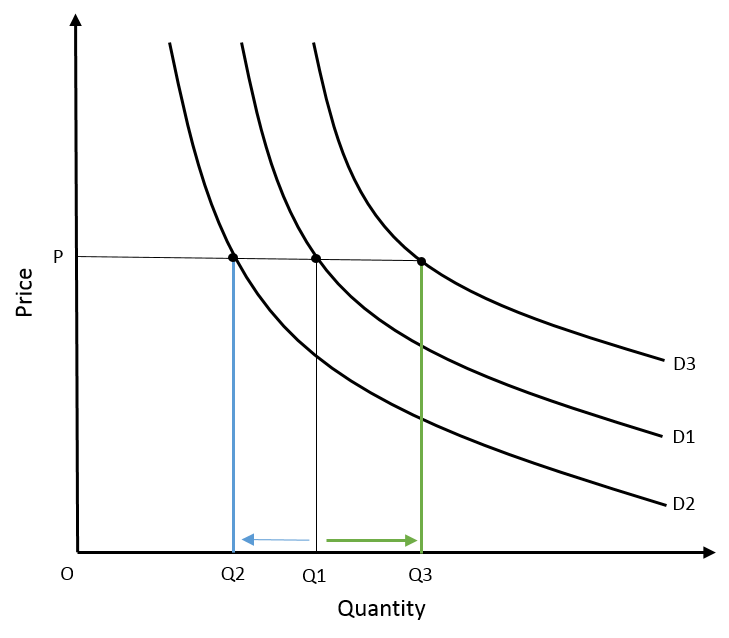
Change in demand occurs as a result of changes in other determinants of demand, with price remaining constant. It may happen due to a change in the income of consumers, a change in the price of other goods or several other reasons.
If the demand curve shifts to the right, as in the case of D1 to D3, the quantity demanded of that commodity will increase from Q1 to Q3. Conversely, if the demand curve shifts to the left from D1 to D2, the quantity demanded will fall from Q1 to Q2. The price of the commodity remains constant at P.
| RIGHTWARD SHIFT IN DEMAND | LEFTWARD SHIFT IN DEMAND |
| A rise in income of the consumer | Fall in the income of the consumer |
| A rise in prices of substitutes | Fall in prices of substitutes |
| A fall in the price of complementary good | A rise in the price of complementary good |
| Decreased taxes on the good | Rise in taxes on the good |
| The expectation of rise in price in future | The expectation of a fall in price in future |
| Increase in preference for the good | Decrease in preference for the good |
slope of the demand curve and exceptions to the law of demand
The downward slope of the demand curve
Law of diminishing marginal utility
The law of diminishing marginal utility states that the satisfaction derived from the consumption of a good decreases with an increase in the amount of that good consumed. Since the marginal utility falls with an increase in the quantity of that good consumed, consumers will buy more of that commodity only at a lower price. This happens because the satisfaction derived from each incremental unit of that commodity keeps decreasing. Hence, the demand curve is downward sloping. That is, more quantity is demanded only at lower prices.
Multiple uses of a commodity
Goods have multiple uses and some of these uses are more important than others. At high prices, goods are consumed only for their most important purposes. However, when the price of a commodity falls, consumers may start to use that commodity for other less important purposes as well. This leads to a rise in the quantity demanded. For example, with a fall in the price of milk, consumers will start to buy more milk for other uses such as making butter and yoghurt.
Price effect
Price effect refers to the changes in quantity demanded of a commodity due to a change in its price. For normal and inferior goods, a fall in the price of a commodity leads to an increase in its quantity demanded. That is, more quantity is bought at lower prices. The price effect can be decomposed into the following:
Income effect
For normal goods, the income effect is the resultant rise in real income or purchasing power of consumers from a fall in the price of a commodity. As price falls, purchasing power rises and consumers can buy more of that commodity.
Substitution effect
It is the impact of a change in relative price of a commodity as compared to its substitutes. Hence, as the price falls, consumers begin to substitute that commodity in place of other related goods. The quantity demanded of that commodity rises.
Exceptions to the Law of Demand
- Giffen goods: Giffen goods represent a rare case where the quantity demanded of a commodity falls even with a fall in its price. This happens because the magnitude of the negative income effect of these goods is greater than the positive substitution effect, leading to a negative price effect as a whole.
- Luxury or Veblen goods: the quantity demanded of luxury goods rise with a rise in their price because these goods act as a symbol of status. Hence, the higher the price of these goods, the higher will be their demand.
- Expectations: the law of demand can break down in certain situations where consumers expect the prices to change in the future. For example, if they expect the price to rise in future, they will buy more of that good even at high prices.
- Necessities: certain commodities have a minimum quantity that a consumer must buy. For example, a certain minimum quantity of food is necessary for survival. Hence, consumers will buy some minimum quantity of such foods irrespective of a rise in prices of these food products.
- Emergencies: situations such as war may create shortages or other emergency circumstances leading to a breakdown of the law of demand.
Supply and its determinants
Price (P)
Normally, the supply of a commodity is positively related to price. A rise in price leads to a rise in the quantity supplied of that commodity. This is because producers will offer more for sale at higher prices in order to increase their profits. However, some commodities such as agricultural products are exceptions to this because the supply of these goods cannot be increased in the short run. For instance, once wheat is planted in the fields, its supply is fixed and cannot be increased whenever the producer wants to.
Input prices (I)
Prices of inputs or factors of production determine the costs involved in the production of a commodity. A rise in input prices reduces the profit margin of producers, therefore, reducing the supply of the commodity. A fall in input prices, on the other hand, makes the commodity more profitable and producers offer more of it for sale.
Goals of the firm (g)
Generally, profit maximization is the goal of producers. In some cases, however, the goal of the firm can be different. For example, the goal may be revenue or sales maximization, which plays a huge role in determining the supply of that good.
Prices of related goods (Pr)
Prices of related goods, especially substitutes, can affect the supply of a commodity. If the price of a substitute rises, the producers may shift their production to that good to maximize their profits. In such a situation, the supply of the commodity will fall.
Technology or techniques of production (T)
Improvement in technology and new inventions can greatly reduce costs of production, thereby, increasing the profit margins of producers. With innovation, the supply of a commodity will rise as its cost of production falls.
Government policy and taxation (G)
Similar to demand, government policies such as taxation can affect the supply of a good. An increase in taxation raises the price of a commodity. The burden of that rise in price falls on the producer as well because taxation increases the cost of production. Therefore, higher taxation generally leads to a fall in the supply of a commodity.
Expectations (E)
Suppose, producers expect the price of a commodity to rise, then they will hoard the commodity instead of selling it. When the prices rise in future, producers will sell their hoarded stock of commodities at higher prices. Hence, expectations of price changes in future can have a huge impact on supply.
Natural factors (N)
The role of natural factors holds especially true for agricultural commodities because their production depends on a variety of natural factors. Disasters such as droughts or floods can hugely impact the production and supply of agricultural goods.
Law of supply
Other things remaining constant (ceteris paribus), supply or the quantity of a commodity that firms offer for sale in the market increases with a rise in its price and decreases with a fall in its price. Therefore, there is a positive relationship between price and quantity supplied.
S = f(P, I, g, Pr, T, G, E, N……)
where Input prices (I), Technology (T), Price of related goods (Pr), Expectations (E) Government Policy and taxation (G), Goals of the firm and Natural factors remain constant.
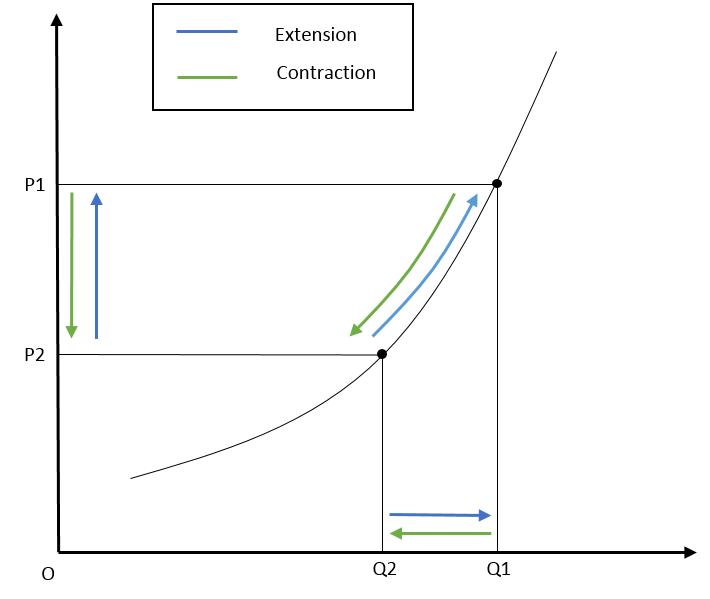
With changes in the price of a commodity, its supply also changes. Extension of supply is a situation where a rise in the price of a good leads to a rise in supply. This is shown in the figure as supply increases (Q2 to Q1) when the price rises from P2 to P1.
On the other hand, a fall in price causes the supply of that commodity to fall from Q1 to Q2. This is referred to as the contraction of supply.
Assumptions
- Input prices are constant.
- No change in the price of related goods.
- Technology remains constant.
- No change in goals of the firm.
- Government policy or taxation stays the same.
- No change in expectations.
Relaxing the assumptions of the law
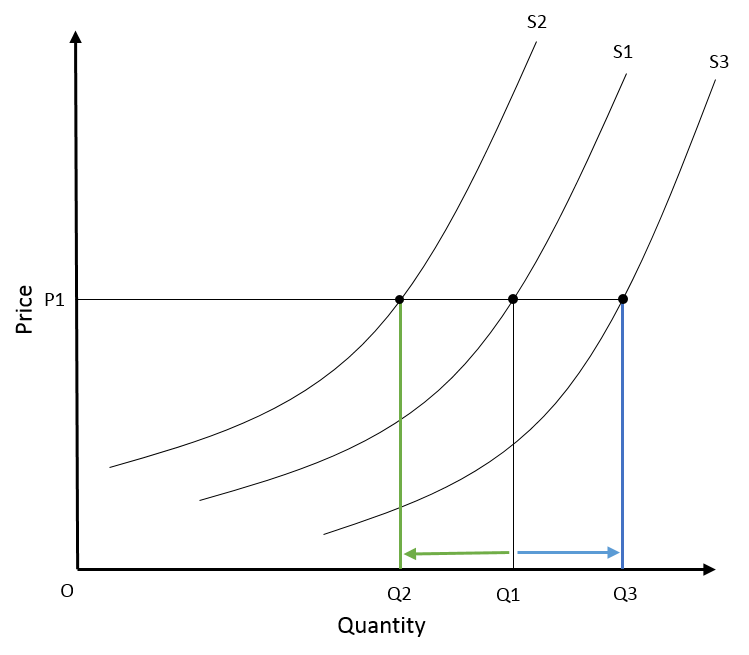
Shifts in the supply curve occur due to changes in factors other than the price of the commodity. For instance, a change in input price or government policy can shift the supply curve. As the supply curve shifts to the right from S1 to S3, the quantity supplied increases from Q1 to Q3.
The shift of the supply curve to the left from S1 to S2 causes the quantity supplied to fall from Q1 to Q2.
| RIGHTWARD SHIFT IN SUPPLY | LEFTWARD SHIFT IN SUPPLY |
| Fall in input prices | Rise in input prices |
| Fall in prices of substitutes | Rise in prices of substitutes |
| Fall in taxation | Rise in taxation |
| Expectation of fall in price in future | Expectation of rise in price in future |
| Shift to sales maximization | Shift to profit maximization from sales maximization |
| Improvement in production technology | Natural disasters |
exceptions to the law of supply
Vertical supply curve: supply curve can be vertical in the case of rare goods. This happens because the supply of such goods is finite and cannot be increased or decreased. Additional, the supply curve can be vertical for some goods in the short run. For example, the supply of agricultural goods is constant in the short run. The production of goods like rice or wheat requires a long period of time.
Backward bending supply curve: in the situation of rising wages, the supply curve of labour can be backward sloping because labour starts to prefer or value leisure more than work beyond a certain level of income.
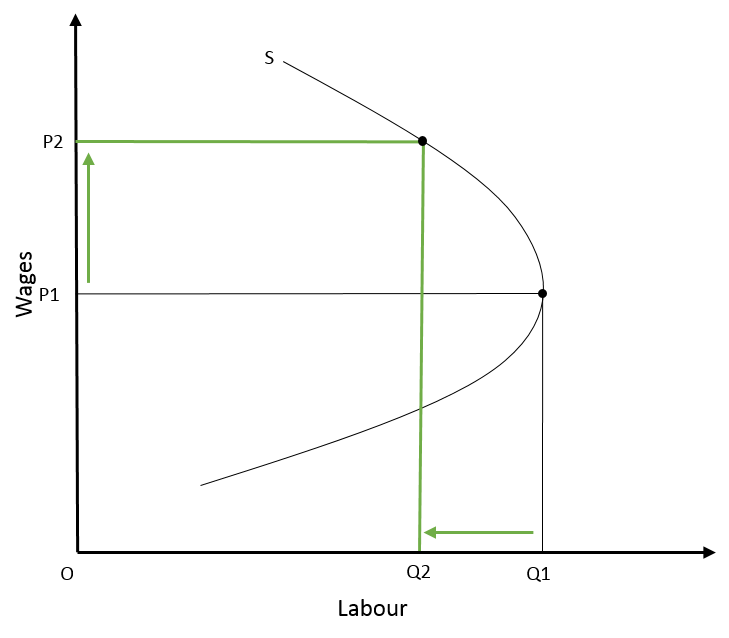
Econometrics Tutorials with Certificates
This website contains affiliate links. When you make a purchase through these links, we may earn a commission at no additional cost to you.


